It’s Time to Order Seeds
Posted on Wednesday, February 16, 2022 · Leave a Comment

Hope is a Verb dahlia
When I was a young man my mailbox was often blessed with seed catalogs at this time of year. Now? Not so much. Back then I poured over them. I drooled over the listings. I wrote checks for small amounts and mailed them off to the companies offering the best sounding varieties.
Now? Most seeds are sold on-line. Yes, my favorite feed-and-grain store, some hardware stores and the local food coop still sell seeds over the counter. And I do get a few catalogs in the mail. But seeds are largely sold through the internet.
One company that still sends me a catalog in the mail is called “Seeds from Italy” (also at
www.GrowItalian.com). Based in Lawrence, Kansas, I’ve been following this company since a friend of mine bought it in 2011. His son, Will Nagengast, just took over and I called him to chat a bit after I got his catalog.
According to Will, the American palate is just discovering bitter vegetables. Italians, however, have been eating and enjoying those distinct flavors for a long time. So they feature many vegetables that are not commonly sold by other seed companies; they market seeds from Italy.
One I have tried is Cima di Rapa or broccoli raab, which I often see in cooking magazines, but not at the grocery store. It is unpleasant unless cooked, but cooked it is much like broccoli. It does not form a big head like broccoli, however –it’s all side shoots.

Radicchio Rosa is good raw or cooked
Do you like arugula? They sell 5 kinds, including a wild arugula (which can seed in if you let it). Then there are a dozen kinds of radicchio, including a pink-leafed one (Radicchio del Veneto) that Will says is very popular. Never grown radicchio? It can be eaten raw in a salad, or fried with bacon and shrimp, or put in a stir fry or soup. Grilling or cooking it makes the flavor sweeter. Most varieties are red-leafed and round, but some are elongated like romaine lettuce.
I’m ordering seeds for a winter squash Will recommended: Butternut Rugosa. He says it is much larger than the Waltham butternut I normally grow: up to 30 or 40 pounds! He said it keeps for up to 4 months in a cool, dry place. He oven-roasts them and then freeze most of these big squash. Will uses the sweet, creamy meat for making homemade ravioli.
Fruition Seeds in the Finger Lake Region of New York State was started in 2012 by Petra Page-Mann and Michael Goldfarb. They are fully organic farmers, and most of what they grow are heirloom seeds, but they have developed a few varieties themselves though their breeding program. They encourage their customers to save seeds and use their own. I called Petra recently to see they have added to their seed line.
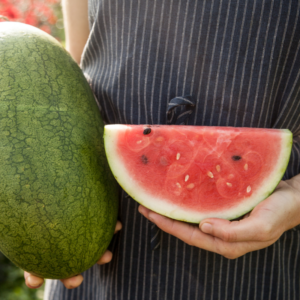
August ambrosia is fast growing and sweet
August Ambrosia is a short-season watermelon that Fruition developed over a six-year period in collaboration with Cornell University. They tested it each year with visitors to the farm to get just what people wanted: sweet, juicy melons that, even if planted in June, will produce ripe melons in August. The rinds are thin and the seeds are small. Petra told me on the phone that you can eat the seeds – or have fun spitting them!
“Food is so social. Growing and sharing food is how we remember to be human,” Petra told me. So she welcomes visitors to the farm, and shares her food – and her fantastic enthusiasm – with her visitors. And she learns what appeals to her customers, which is good business.
Fruition sells seed for two interesting cabbages: Kalibos is a deep purple cabbage, cone shaped, with big hips. According to the website, it is best as a fall cabbage; sow in early or mid-July for best results. You can seed them in 6-packs in early July, and transplant them into the garden in early August at two-foot spacing. Harvest them in October and November to get heads of optimal size and sweetness.

Mermaid’s Tale cabbage
Mermaid’s Tale is a cross between Kalibos and early green cone-headed cabbage. Each one is unique in color, shape and flavor: lime green to emerald with lavender to burgundy veining. Sharp or subtle flavor.
Another specialty of Fruition Seeds is their “Hope is a Verb” dahlia. Each seed is unique and each flower is different, made from innumerable crosses of dwarf and semi-dwarf collarette-style dahlias. Petra explained to me that dahlias have 8 sets of chromosomes, and consequently have many ways of expressing their genes. The plants are two-feet tall or less, with blooms one to three inches across. She said they are fabulous for short-seasons and lower light conditions. I shall start some.
Lastly I shall order Spotlight Snow Peas from Fruition Seeds. Some will be green, some purple, some mixed colors. They are very early (or late if planted in early August for a fall crop), very sweet, and 3-feet tall or less. Petra says they taste great and only take 52 days to harvest!
Every company has something unique and wonderful. Buy your seeds now, as some seed companies will sell out their seeds before summer. And if you haven’t tried starting seeds indoors, I’ll tell you about that next week.
Henry can be reached by e-mail at
henry.homeyere@comcast.net or at PO Box 364, Cornish Flat, NH 03746. He invites your comments and suggestions. He is the author of 4 gardening books.
Starting from Seed
Posted on Tuesday, January 26, 2021 · Leave a Comment
I hate to be the one to give you bad news, but some seed companies are already running out of seeds. Don’t panic: there are, in fact, plenty of seeds out there. And if one company doesn’t have your favorite tomato or zinnia variety, chances are that some other company will.
Before panicking, you might want to go to your local feed-and-grain store, garden center or food coop for seeds, too. Most of those have racks of seeds, some with just one brand, others with several.

Heirloom tomatoes are often irrecular in size and shape but they are tasty and you can save seed for next year
Most seeds are good for 3 years. Of the seeds I use, onions and parsnips are just good for just one year. Peppers, parsley, corn and leeks are good for two years. Most of the cabbage family (kale, broccoli, etc.) and squash family (cukes and zukes) are good for four years. Basil and some flowers are good for five years.
You can prolong the viability and vigor of your seeds by storing them properly: they do best in a dark, dry place cooler than 40 degrees. Freezing is fine, too, but put them in an airtight container. In fact, that’s always a good idea.
Despite what I wrote above, I have germinated seeds much older than the suggested limits when I have not been able to find the varieties I wanted. There are downsides to using old seeds. They generally germinate at much lower rates. You can test this by wrapping ten older seeds in a paper towel and keeping it moist on a sponge. If less than half germinate in a week or two, buy new seeds. You can do that now, before you place your seed order.
Older seeds also have less vigor. That is the main reason I avoid them, even if they will germinate at 60 %. Not all seeds are created equal, and I want those that are ready to explode with pent up energy, ready to grow.
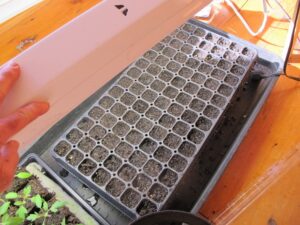
Corn seeds planted in plug tray indoors
It’s important to know what seeds need to be started indoors, and which can do well planted directly in the ground. All your root crops are best started outdoors in the ground, though beets can be started indoors. Beans and peas are direct seeded outside, too. Corn can be started in the ground, or indoors in flats. Crows love freshly germinated corn seeds with a little green leaf, so planting 4-inch plants started indoors is good if you have just a small plot.
Although you can start the vine crops directly in the soil, I have troubles with striped cucumber beetles killing the young plants when they first germinate by stripping them of their first leaves. So I start squash-family vines in small pots indoors a month or so before outdoor planting day, and the plants are big enough to survive some leaf damage by those insect pests.
Tomatoes, eggplants, broccoli, cauliflower, cabbage, kale and lettuce I start indoors in April or buy in 6-packs. Peppers and some flowers need to be started indoors very early: March 1 is good where I am.
What are my favorite companies? This year I ordered most of my seeds from FEDCO Seeds, a co-op based in Maine. I like that it’s a cooperative and does everything in a low-key, sustainable way: their catalog has no color pictures designed to make me drool. They offer small seed packs for as little as $2.00. And instead of saying that every tomato variety is “The Best Tasting” they tell the flaws as well as the positive attributes of each variety.

Catalogs are great fun to study
I always get some things from Johnny’s Selected Seeds, an employee-owned company in Maine that is favored by commercial growers. They provide excellent growing information. This year they provide excellent comparison photos in each section – all their tomatoes, side-by-side, for example.
Last year I tried John Scheepers’ Kitchen Garden Seeds and liked them a lot. If you are interested in unusual vegetables like shiso, Karikachi edamame, tatsoi, mizuna and other Oriental veggies, they have plenty to choose from. They even have peanuts for northern gardeners! Like Fedco, no color photos in the catalog.
Like Italian food? Seeds from Italy carries the Franchi brand Italian seeds, and more. They also have kitchen items, garden tools and more. All high quality.
Hudson Valley Seeds started as a seed library in New York State, and became an excellent seed company with seeds others do not carry, like their Siberian watermelon.
Fruition Seeds in upstate New York is another favorite of mine. They grow much of their seed on their 24-acre farm, specializing in heirloom seeds for short seasons like those we have in New England. They have some nice varieties not found elsewhere. The owners are young and full of energy, and grow only organic seeds.
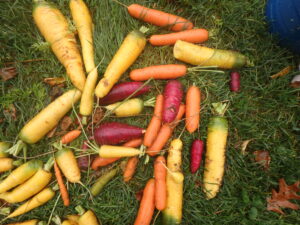
Carrots and most root crops need to be planted directly in the soil
Renee’s Garden Seeds has great seeds – but no print catalog. Still, I order from them most years. I love their mixes of different color veggies in one pack – 3 colors of beans, or two colors of carrots.
And lastly, don’t forget Burpee Seeds, one of the oldest and biggest seed companies for the home gardener. They sell lots of varieties that they have developed, especially disease-resistant hybrids.
So get busy, and buy your seeds now before all get sold!
You may reach Henry at
henry.homeyer@comcast.net or PO Box 364, Cornish Flat, NH 03746. Henry’s book, Organic Gardening (not just) in the Northeast: A Hands-O Month-by-Month Guide has been re-printed and is now available from him for $19.
Holiday Gifts for the Gardener
Posted on Wednesday, November 30, 2016 · Leave a Comment
It’s that time of the year again: time to figure out good gifts for Uncle Albert and your sister Sadie. If they’re gardeners, gifts are easy to pick. There are plenty of items that cost from $5 to $300, and generally, one size fits all. Let’s look at some things I have used and like.
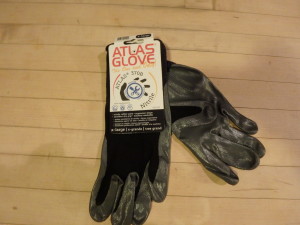
Nitrile Gloves
After giving a talk at the Milford, NH Garden Club recently, I bought some gardening gloves that were being sold as a fund raiser. These cost me just $5, and have already earned their keep. These are nitrile gloves made by the Atlas Glove Company. They have a waterproof palm and a stretchy, breathable fabric back. I have big hands, and the x-large size was perfect. Mine are black with silver palms, but the smaller sizes come in a variety of colors.
I don’t generally wear gloves when gardening, as most are too thick – and I like the feel of the soil – but in cold weather I do wear them. These are thin enough that I can go easily in my pants pocket and pull out my pocket knife, or feel a tender weed. The nitrile glove is the Atlas 370B series. I’ve also used a thicker Atlas glove with a natural rubber palm, the 300 series. These are both available at most gardening centers.
Does your loved one start plants by seed? Gift cards at garden centers or seed companies are nice. I get my seeds from several places: the Hudson Valley Seed Library, Johnny’s Selected Seeds, High Mowing Seeds, Renees Garden and a young company in New York State, Fruition Seeds. All have wonderful selections.
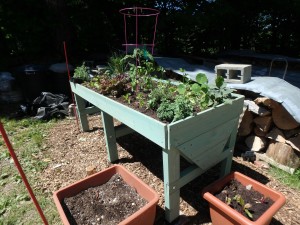
VegTrug
One of my favorite additions to my garden this year was a “VegTrug” from Gardener’s Supply Co. (www.gardeners.com, Item#8586918). This is a stained cedar planting box on legs, about 6 feet long and 32 inches wide that retails for $279, with free shipping. It is V-shaped in cross section with the deepest portion 16 inches deep – deep enough for potatoes or tomatoes. It stands 32 inches tall, so no bending is needed to weed or to pick.
In my VegTrug I grew one patio tomato and pretty much every kind of herb: basil, dill, marjoram, thyme, sage, purple sage, chives, oregano and parsley. I even had a nasturtium cascading over one end.
One reason I loved my VegTrug was the convenience: it allowed me to have herbs near the house in a spot not otherwise suitable for growing. And the plants grew well, although in the heat of the summer they dried out more quickly than my garden near the stream, so I watered pretty much every sunny day. It uses 380 liters of soil mix, so I made my own, a 50-50 mix of peat moss and compost. The bottom is slotted for drainage, but it comes with a woven liner to prevent soil from washing away.
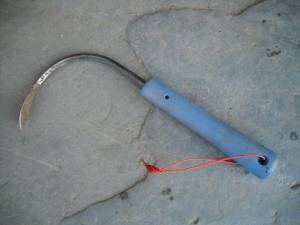
Cobrahead
Every gardener needs a good weeding tool, and every year I recommend the CobraHead Weeder, because I believe it is the best weeding tool available. This tool has a single tine that is curved like the shape of a rising Cobra. I use it to tease out grass roots, to get under large weeds (so I can loosen the soil below them and pull from both top and bottom of the weed at the same time), and for preparing soil to plant. Now it seems a part of my right hand (though it is right-left neutral). At under $25 locally or from the manufacturer (a family business found at www.CobraHead.com), this tool is tough, strong, and made in the USA.
Every year I try to learn more about growing healthy plants. This year I paid $50 to join the Bionutrient Food Association (http://bionutrient.org/), and would like to suggest giving a membership as a nice present. One of the goals of the non-profit is to educate members about how to grow food that is nutrient-rich.
Much commercial agriculture depends on adding just 3 minerals to the soil (nitrogen, phosphorus and potassium) and basically ignoring the other nutrients that plants – and humans – need to be healthy. Growing vegetables year after year removes micronutrients from the soil that need to be replaced. The BFA offers information and workshops that I believe will help me to grow better food and stay healthy.
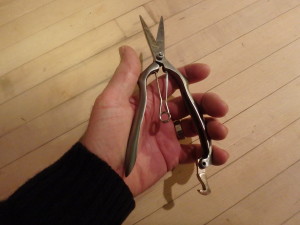
Garden Shears
Weeds are the bane of many gardeners. One way to minimize their presence is to weed daily, mulch, or to put down weed mats. A Vermont company, Garden Mats (https://gardenmats.com) produces heavy-duty woven mats with pre-cut holes in a variety of patterns for different vegetables. I’ve used them – and re-used them. They keep down weeds, hold in some moisture, but also breathe and let rain penetrate. They are 4 feet wide and come in lengths of 6, 12 and 18-feet for a cost of $11 to $31. They are definitely a labor-saver, and they claim the mats increase yields 10% to 20%, too. I like them, and also the fact that it is a small, family-owned business.
The last item for this year’s list is a lovely pair of stainless-steel garden shears for cutting flowers, herbs, and for use in the kitchen. Made in England, these shears are elegant as well as sturdy, and are said to be designed for small hands. Sold by Gardeners Supply (Item#8593404), they retail for $60 and come in a handsome gift box.
Santa, if you’re listening, I have everything I need. So you can just volunteer to come work in my garden next summer. I know it’s the off-season for you, and we both need to lose some weight, anyhow. We can pull weeds and eat cukes.
Read Henry’s blog at https://dailyuv.com/gardeningguy. You can get an email update every time he posts.














